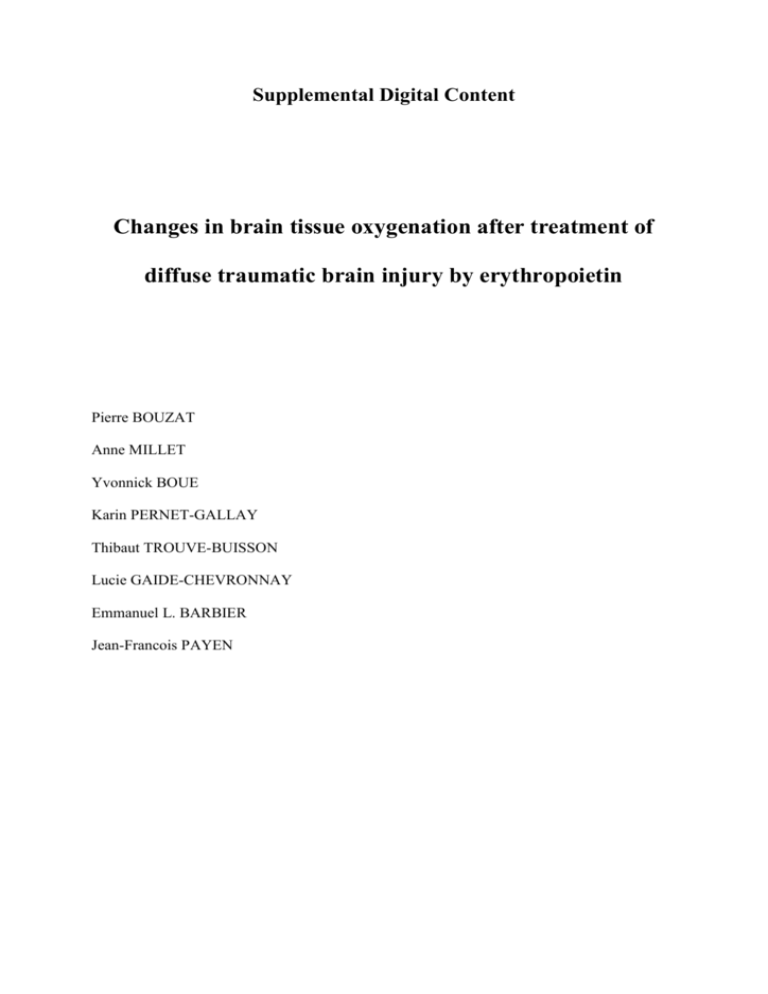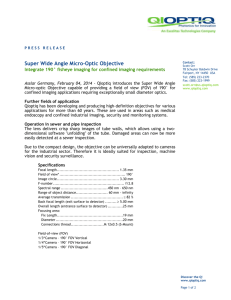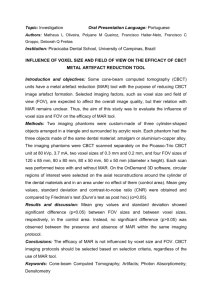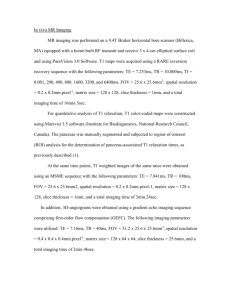Supplemental Digital Content Changes in brain tissue oxygenation
advertisement

Supplemental Digital Content Changes in brain tissue oxygenation after treatment of diffuse traumatic brain injury by erythropoietin Pierre BOUZAT Anne MILLET Yvonnick BOUE Karin PERNET-GALLAY Thibaut TROUVE-BUISSON Lucie GAIDE-CHEVRONNAY Emmanuel L. BARBIER Jean-Francois PAYEN Supplemental Digital Content 1. MRI imaging The protocol for MRI acquisition included successive sequences to assess brain edema using diffusion-weighted imaging, local brain oxygen saturation using a multiparametric quantitative blood oxygenation level-dependent (BOLD) approach (1), cerebral perfusion using a dynamic susceptibility approach allowing the determination of mean transit time (MTT) of an intravenously injected contrast agent (2), and blood volume fraction (BVf) using a steady-state approach (3). Anatomical T2-weighted images were acquired using a 2D spin-echo sequence and the following parameters: repetition time (TR) /echo time (TE) = 4000/33 ms; one average; 13 sections with 30x30 mm2 field of view (FOV); matrix = 256x256; voxel size = 117x117x1000 μm3. Acquisition duration was 2 min 8 sec. The apparent diffusion coefficient (ADC) of water was mapped before and 2 h after the trauma using 2D diffusion-weighted, spin-echo, single-shot echo-planar imaging (EPI): TR/TE = 2500/30 ms; FOV = 30x30 mm2; matrix = 64x64; 8 averages; voxel size 468x468x1000 µm3. This sequence was applied four times, once without diffusion weighting (b~0 s.mm-2) and three times with diffusion weighting (b = 800 s.mm-2) in three orthogonal directions, in order to map the ADC. Acquisition duration lasted about 5 min. T2 was mapped using a 2D multiple spin-echo sequence: TR/TE = 1500/15 ms; 20 spin echoes; TE = 12 ms; one average; FOV = 30x30 mm2, matrix = 64x64 and voxel size = 468x468x1000 μm3). Acquisition duration was 1 min 36 sec. B0 was mapped using a 3D multiple gradient-echo sequence: TR/TE = 100/4 ms; 15 gradient echoes; TE = 4.5 ms; one average; FOV = 30x30x6 mm3; matrix = 96x128x30; voxel size = 234x234x200 μm3. Acquisition duration was 4 min 48 sec. T2* was mapped before and after an intravenous administration of ultrasmall superparamagnetic particles of iron oxide (USPIO): TR/TE = 6000/4 ms; 15 gradient echoes; TE = 4 ms; one average; FOV = 30x30 mm2; matrix = 64x64; voxel size = 468x468x1000 μm3. Acquisition duration was 38 sec. A dynamic 2D-echo-planar imaging (EPI) gradient echo sequence was also acquired: TR/TE = 250/12 ms; two segments; two sections; one average; FOV = 30x30 mm2; matrix = 64x64; voxel size = 468x468x1000 μm3. Acquisition of one image lasted 0.5 sec and the EPI sequence was repeated 120 times (total duration 1 min). After image acquisition during a 10-sec baseline, USPIO was intravenously injected (100 µmol of iron per kg of body weight; P904, Guerbet, Roissy, France). At the end of the EPI sequence, a second dose of USPIO (100 µmol/kg) was intravenously injected to permit the acquisition of the second T2* map in the static dephasing regime (total dose of USPIO: 200 µmol/kg) (4). References 1. Christen T, Lemasson B, Pannetier N, et al: Evaluation of a quantitative blood oxygenation level-dependent (qBOLD) approach to map local blood oxygen saturation. NMR Biomed 2011; 24:393-403 2. Barbier EL, Lamalle L, Decorps M: Methodology of brain perfusion imaging. J Magn Reson Imaging 2001; 13:496-520. 3. Tropres I, Grimault S, Vaeth A, et al: Vessel size imaging. Magn Reson Med 2001; 45:397-408. 4. Valable S, Lemasson B, Farion R, et al: Assessment of blood volume, vessel size, and the expression of angiogenic factors in two rat glioma models: a longitudinal in vivo and ex vivo study. NMR Biomed 2008; 21:1043-1056








